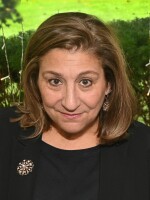Renita Mollman, chief administrative officer at the Kansas City-based engineering firm Burns & McDonnell, doesn’t bat an eye as she explains how high-use “touch-points” like door handles and cabinet knobs will be equipped with disinfectant strips from now on, and only one person at a time will be allowed in common areas and kitchens larger than those in many one-room apartments.
Diner-like booths and conference rooms with walls of white board will now be limited to about half their capacity.
Social distancing will be a change for Burns & McDonnell. Mollman says the company has a culture of gathering.
“Any given day we might have a few dozen people here from other offices, (maybe) several hundred if we’re having a big meeting,” Mollman says. “We definitely like to get people together, to collaborate and get to know each other on a personal level.”

Many of Kansas City’s largest companies are in the same boat.
T-Mobile, Cerner, Black & Veatch and Hallmark are all scrambling to find ways to recreate once collective hives of creativity in an era demanding masks, extreme sanitation and small groups. Some are even considering having some employees continue to work from home permanently.
At Burns & McDonnell, Mollman says the plan is for everyone to eventually come back and work at the office, but probably not before the end of the year. Those in a high-risk category, or taking care of children or family members may stay home even longer.
“We’re going to be very flexible,” Mollman says.

Acres of cubicles tell the story of a workplace evacuation.
Some desks are strewn with papers, coffee mugs and notebooks, as if they were abandoned on a moment’s notice.
Other cubicles are empty. Cables and USB cords are unplugged, resting on the clean, white desktops. No chairs.
“Most of those are people who have taken their computers home, their monitors, laptops, desktops,” she says. “A lot of them took their chairs home as well."

In the cafeteria, small square tables are spread out to accommodate the ten-foot social distancing rule. These are typically crowded with workers eating the free lunch the company provides. Communication officer Kristi Widmar says there will be less buzz.
“This will have a different feel,” she says.
There are still many unanswered questions about how this reopening will look, Mollman says.
Managers are moving slowly with the process, she says, bringing about a quarter of the workforce back maybe every four to six week. They’re still researching what to do about testing or contact tracing..
“Over the next few months we’ll just have to see how all this shakes out with the virus,” she says. “We want to do everything we can not to spread the disease.”






